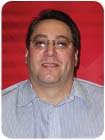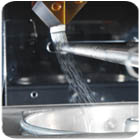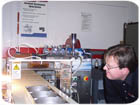
Vic Bach, engineering manager, AutoJet Technologies, Wheaton, IL.
AutoJet Technologies is an offshoot of Spraying Systems Co., a fabricator of spray balls and nozzles for clean-in-place systems and other spraying applications. The division was formed to engineer turnkey solutions to minimize overspraying, misting and product rejects caused by excess coating. Customized software and controllers with conventional nozzles often are solutions, but electrostatic spraying optimizes transfer efficiency, and some specialty applications clearly could benefit from the technology, provided energy and cost challenges could be overcome.
Heading the system design effort at AutoJet is Engineering Manager Vic Bach. Bach joined Spraying Systems seven years ago, shifting to the AutoJet division when it was formed in 2000. A native of Michigan's Upper Peninsula, Bach earned his degree in mechanical engineering from Michigan Technological University in Houghton. He has specialized in valves and other electro-mechanical components for the last 10 years.

A close-up view of the system depicts the fluid particles bending toward the inductor bar and then downward toward the target's surface. Source: AutoJet Technologies.
Bach: The company looked at the technology for 25 years, but system costs and the huge amounts of energy required to create small particles without air made electrostatic spraying in food plants impractical. Then, about two-and-a-half years ago, a bakery customer asked us to develop a coating system that would deliver a more even, thinner oil coat, so we decided to try it again, using a different approach.
Conventional systems rely on air atomizing nozzles or hydraulic nozzles. With air atomizers, transfer efficiencies are typically in the 60 to 90 percent range because of misting and overspraying. With hydraulic atomizers, efficiency goes up, but the droplets are larger, and it's hard to achieve high efficiency because the coating is thicker.
FE: Electrostatic spraying has been used for many years in painting and coating. Couldn't existing electrostatic technology do the same as your system?
Bach: With electrostatic painting, up to 100 kilovolts (KV) are required, which raises worker safety issues. The fluid is charged in midstream, after it has been pushed out of the nozzle. By charging the fluid in the nozzle, we were able to achieve greater control and less opportunity for particles to go off into space.
We're charging at such a high voltage that the target doesn't have to be positively charged but at significantly lower energy rates than electrostatic painting. If the target is approximately grounded, the negatively charged fluid will be attracted to it. Once an area is coated, it is negatively charged and will repel the fluid that follows. Those particles will seek an open spot on the target; the spray will actually wrap around the target's surface. As a result, we're able to achieve transfer efficiencies much greater than 90 percent.
Electrostatic painting equipment can be air atomized or airless. In most airless systems, high pressure atomizes the spray. By using very low pressures and charging the fluid in the nozzle, we've been able to develop a compact, relatively inexpensive system. A patent application is pending on the design.

A technician observes the performance of an electrostatic spray unit in the laboratory at Spraying Systems Co. Fluid is negatively charged before exiting the nozzles mounted above the conveyor.
Bach: It's much different than most of the nozzles we make. A bank of nozzles is embedded in a block made of a lightweight, dielectric polymer. Charging occurs inside this nonconductive housing.
With a hydraulic nozzle, the shape of the orifice is everything, and the machining is very precise. With these, the shape doesn't create the spray pattern; they're really just stainless steel tubes. Depending on the coating thickness required in the application, we can get droplet size down to 50-70 microns. Once the droplets leave the nozzle, they pass a grounded inductor bar fabricated from a grade of aluminum that doesn't retain a charge and with a rubberized piece at the top. The fluid is drawn toward the bar, and as it passes, it starts to break into tiny droplets. There have been great advances in understanding particle physics since the 1980s, and we've been able to enhance our understanding in our lab.
FE: What types of fluids can be sprayed?
Bach: Viscosity and conductivity are the limiting factors. We're putting together a database of fluids with enough conductivity to carry the charge. If it's not conductive, the fluid exits the nozzle and passes the inductor bar as a solid stream. You don't get tiny particles.
In terms of viscosity, most food-grade lubricants are 75 centipoise and under. If the fluid is in that range, it's not a problem for this system.
One of the keys is that the fluid exits the nozzle at extremely low pressure, typically at 1.5 psi; certainly no higher than 5 psi and possibly below 1 psi. Other nozzles don't even function at those pressures. Because the particles are charged, they're being accelerated and dispersed as they pass the inductor bar. To control them and keep them moving toward the target instead of spraying widely, low pressure is needed.
FE: Why did you undertake the development project?
Bach: Customers asked us for delivery systems with better transfer efficiencies, lighter coatings and less waste. This became the next logical step for us for specialized applications. It's not a very expensive system, and the bakery that installed the coating unit realized a payback in about eight months. But we set out to design something that would have more generic uses.
FE: What other applications have you found?
Bach: Chain oiling is one. Another is lubricating rounded, precision parts that require extremely light coatings. We're also testing an application that involves wire racks that convey an extruded meat product into an oven. The processor currently sprays across the racks and hopes they're coated. The mess that's created is nasty. With electrostatic spraying, the oil is attracted to the racks and actually wraps around the wire. For wire or bar stock, this is a nice solution.
Another potential application is in cereal manufacture. Moist grain feeds down from a bulk hopper and passes between a smooth roller and a crimp roller to form a sheet. If the material fails to separate from the crimp roller because of insufficient coating, the process is out of control. A hydraulic delivery system creates a lot of mess; with electrostatic, you get a uniform, light coating. And it's a continuous process, which is easy for us to apply.
FE: Can intermittent spraying be done?
Bach: We're still refining elements of the design as we speak, including intermittent spraying. In the prototype, a steel bar is inserted into the nozzle housing. Air actuators manipulate the position of the bar, raising and lowering it to cut off the flow or allow fluid to pass through when desired.
The controls are relatively straightforward, based on current system design. If we get into coating odd-shaped components and intermittent spraying, controls architecture will become more complicated.
FE: What is the effective range of charged particles to the target?
Bach: It really depends on the configuration of the target and whether there are single or multiple banks of nozzles. In the lab, where we're charging the fluid with 20 KV, we're typically 2 to 4 inches away from the target. These are very small droplets, so air currents could blow them away and into the atmosphere if the object being coated is too far away. The plastic shroud that partially encloses the system is primarily a worker safety barrier, but it also helps deflect any air currents.